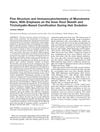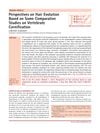Embryonic Keratinization in Vertebrates in Relation to Land Colonization
May 2008
in “
Acta Zoologica
”
TLDR Keratinization in embryos helped vertebrates adapt to land by forming a protective skin barrier.
The study examined the embryogenesis and cytology of the epidermis in various vertebrates, highlighting the formation of a stratum corneum, which was crucial for land colonization during vertebrate evolution. This process involved the development of keratinocytes composed of cross-linked keratins, specific proteins, and lipids, forming an effective barrier against water loss, mechanical and chemical stress, and microbial penetration. The epidermis transitioned from an aquatic to a terrestrial type during advanced embryogenesis, preparing for terrestrial life at hatching or birth. The study detailed the formation of glycine-rich alpha-keratins in embryonic layers and the production of proteins for cornified cell membranes in adult epidermis, particularly in reptiles, birds, and mammals. The evolution of keratin-associated proteins was linked to the development of hard skin derivatives like claws, beaks, nails, and horns.



